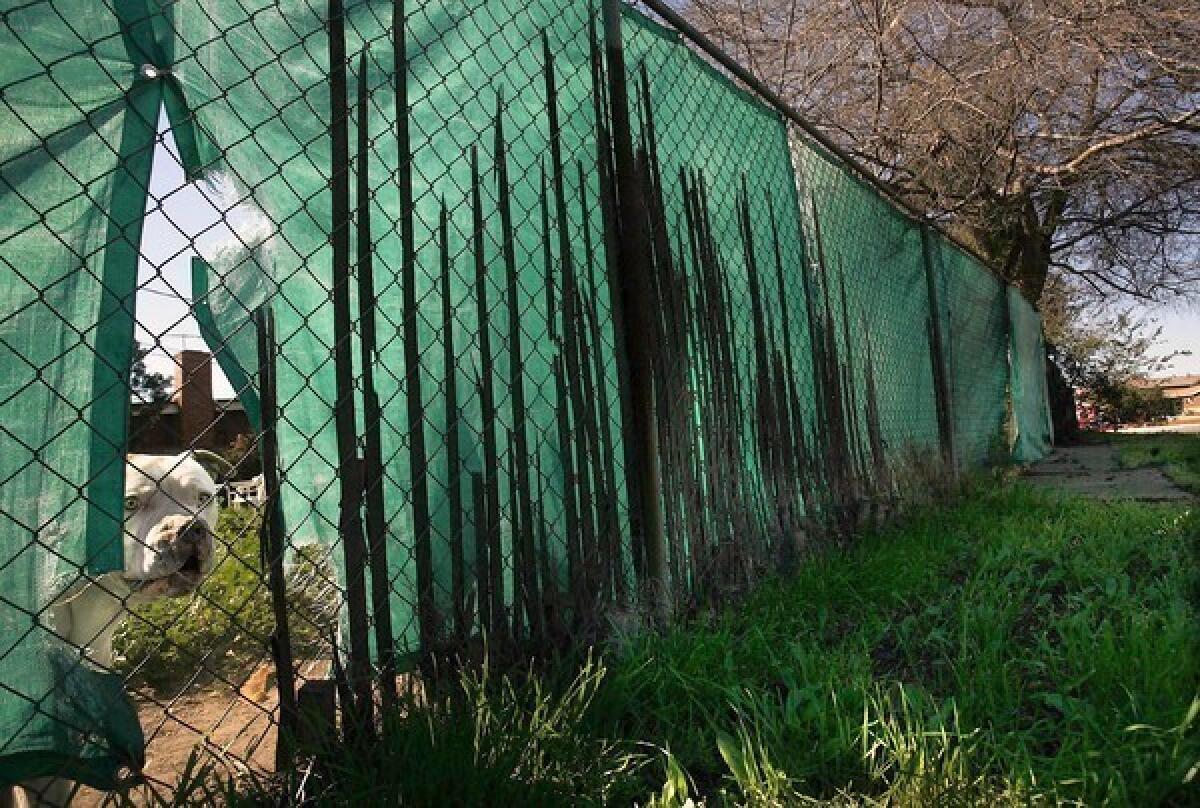L.A. sees parks as a weapon against sex offenders

- Share via
On a tiny sliver of land in Harbor Gateway, the city is beginning construction on what officials believe will be the smallest park in Los Angeles.
At one-fifth of an acre, the pocket park will barely have room for two jungle gyms, some benches and a brick wall.
But the enjoyment the park will give children is a secondary concern for officials. They are building the park for a different reason: to force 33 registered sex offenders to move out of a nearby apartment building.
State law prohibits sex offenders from living within 2,000 feet of a park or school. By building the park, officials said, they would effectively force the sex offenders to leave the neighborhood. This section of Harbor Gateway has one of the city’s highest concentrations of registered sex offenders: 86 live in a 13-block area.
Los Angeles plans to build a total of three pocket parks with the intent of driving out registered sex offenders; two will be in Wilmington.
The action marks the latest campaign by local governments to drive sex offenders farther into the fringes of society. The state law already bans offenders from living in huge swaths of urban areas, pushing them into industrial districts and remote towns and into neighborhoods like Harbor Gateway that lack schools and parks.
Communities in Orange County have passed laws barring sex offenders from county parks and beaches. There is a new push at Los Angeles City Hall to ban offenders from living near day-care centers and locations that house after-school programs.
Backers of the park plan say it’s a novel way to move out offenders while providing more recreation space.
“I want to do everything in my power to keep child sex offenders away from children,” said City Councilman Joe Buscaino, who represents the 15th District, which includes Wilmington and Harbor Gateway. “We have to look at some solutions and in comes the pocket park idea.”
The effort, however, has others questioning whether these restrictions make communities safer and whether they infringe on the rights of offenders.
A California Department of Corrections and Rehabilitation study released in October showed that about 2% of convicted sex offenders are sent back to prison on a new sex-abuse offense. The study covered data from 2008.
“People are running around with hysteria when they don’t know the facts,” said Janice Bellucci, president of California Reform Sex Offender Laws, a nonprofit organization that advocates for the rights of those convicted of sex crimes. “I understand that sex offenders are not a popular part of society, but they have constitutional rights.”
The restrictions on where offenders can live has resulted in a proliferation of group homes in acceptable areas that house large numbers of them. In Harbor Gateway, up to five offenders share one room, according to the National Sex Registry website.
On Flint Avenue in Wilmington, a former hotel has been converted into housing that caters to sex offenders. Young children often walk through the neighborhood on their way to a nearby elementary school. Some residents refer to the area as “pervert row.” There have been several reports of indecent exposure, according to LAPD Officer Brian Cook.
The city now wants to spend $6 million to build a park next to the East Wilmington Greenbelt Community Center. The park would be a block away from the hotel, and city officials said it would force offenders to move out. The city plans to purchase the land from a private owner, address environmental contamination on the site and develop it into a park.
A third pocket park would be built at the Drum Barracks Museum in Wilmington, near another heavy concentration of sex offenders.
Wilmington residents say their neighborhood has become a dumping ground for sex offenders because it lacks parks.
“It’s a tough issue,” said Mary Gant, a Wilmington resident and community activist. “I know they have to live somewhere. But I don’t think you should dump them all in one area.”
In Harbor Gateway, hundreds of residents came on a recent Saturday morning to celebrate the groundbreaking of the park, which was three years in the making.
The city already owns the land and is paying $300,000 to add the equipment and build a brick wall. Community activist Janet Shour and her neighbors sold potpourri and students at 186th Street Elementary School collected 186 pennies a month to go toward park construction. Together, they raised almost $6,000.
Buscaino, a former LAPD officer, said these family neighborhoods deserve to have the offenders removed. He said he isn’t sure where they should go, but added that he would like them to leave his district.
“It’s a good first step in really bringing some comfort to the residents that live in these high-concentrated areas,” he said.
Buscaino and some LAPD officials got the idea for the park three years ago. They looked for properties the city could buy and the city submitted bids on some parcels, but the deals fell though.
Then, in January, LAPD Sgt. Julie McInnis spotted a triangle of empty space near the halfway house. Officials learned that it was owned by the city.
“It really just happened that fast,” said Michael Shull, superintendent of planning, construction and maintenance for the Department of Recreation and Parks.
The park — at the southeast corner of Torrance Boulevard and Denker Avenue — is scheduled to open this summer.
“It’s really great to see the city come around the community,” Shull said.
More to Read
Sign up for Essential California
The most important California stories and recommendations in your inbox every morning.
You may occasionally receive promotional content from the Los Angeles Times.














